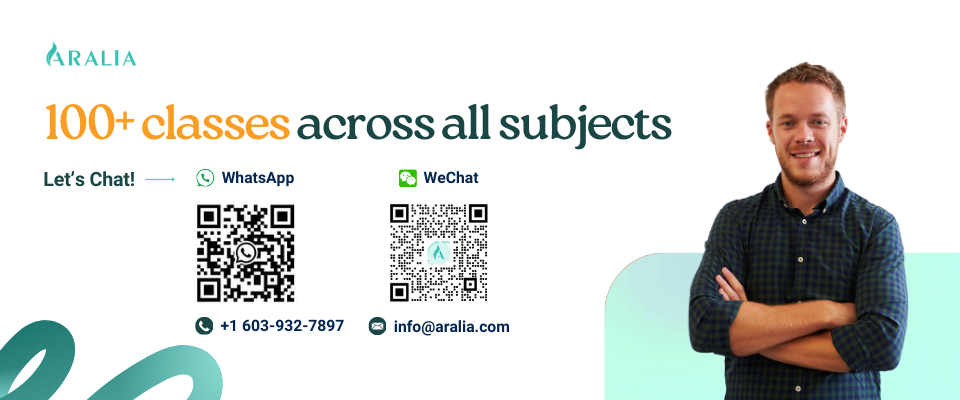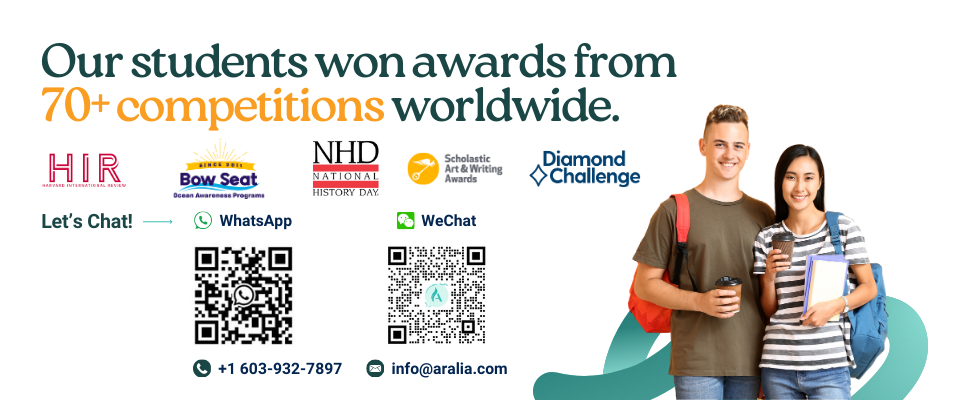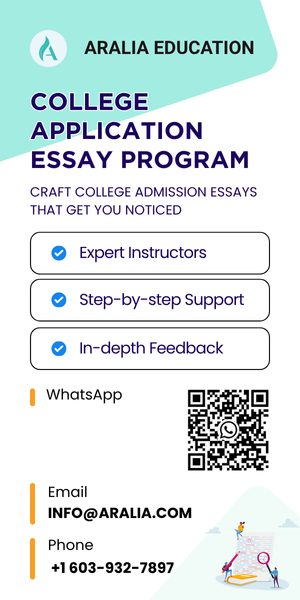81% of Aralia Students Receive Awards in Top Language Competition
1. National Language Arts Olympiad
The National Language Arts Olympiad is a standardized test customized to grade level, and assesses students’ spelling, vocabulary, reading comprehension, analogies, and grammar.
Test Format
There are multiple different versions of the National Language Arts Olympiad exams, because the exam is open to students in grades 2 through 12. For high school students, there is an exam for 9th graders and another one for 10th-12th graders.
National Language Arts Olympiad exams for high school students have 50 multiple-choice questions under a 35-minute time limit. Take a look at some sample tests for 9th graders and for 10th-12th graders. The exams are formatted similarly to the SAT/ACT, with fill-in-the-blank vocabulary and reading comprehension questions.
Eligibility
Students in the U.S. in grades 2 through 12 can take the National Language Arts Olympiad exam corresponding to their grade level. Exams are typically administered through the students’ school. While students answer questions individually, they participate in the Olympiad as teams. The sum of the top ten scores is the school’s team score.
Prizes
Each school’s team will receive 11 awards: 1 medal and 10 certificates. There are also individual and team awards on the national level. The top ten individual’s names and their scores are to be entered on the National Language Arts Olympiad website.
Dates and Costs
The exam window is April 21 through May 2, 2025, and registration is currently open. Exams for the first two teams sent by a school cost $110, and each additional team is $60. Register for the National Language Arts Olympiad through your school and take the test at school—the exam will be proctored and graded by your teachers.
2. National French Contest (Le Grand Concours)
The National French Contest, aka Le Grand Concours, is an online langaueg competition to assess G1-12 students’ interpretive competency in French. In 2024, 44,939 students participated in the contest, making it a very popular option among other extracurricular French language tests available to high school students.
Test Format
The National French Contest has a fast-paced listening portion where speakers talk as quickly as native French people do in France. Other portions of the exam also include French literature passages, newspapers, news clips, and podcasts. Apart from language proficiency, the National French Contest also assesses students on their understanding of French culture, history, and current events.
The National French Contest is split into divisions and levels. Enroll in the appropriate Division and Level based on your French experience as stated in these guidelines.
Divisions:
- Division A – absolute beginner – Can take exams at levels 01-5
- Division B – some outside background – Can take exams at levels 01, 2, and 2
- Division C – completely native – Can take exams at levels 01-5
- Division D – different schedule/block/started next French course second semester – Can take exams at levels 01-5
- Division E – not currently enrolled in a French class – Can take exams at levels 01-5
- Division AP – a student taking Advanced Placement French – Can take exams at levels 4 and 5
There are seven difficulty levels for the National French Contest:
- MS1 (Level 01): Novice Low
- MS2 (Level 1): Novice Mid
- Level 1: Novice Mid
- Level 2: Novice High
- Level 3: Intermediate Low
- Level 4: Intermediate Mid
- Level 5: Intermediate High or Advanced Low
Read more about what’s expected at each level
The practice tests from previous years are available to teachers once they register for an upcoming test. Learn more about the National French Contest.
Eligibility
The National French Contest is open to all students from grades 1 through 12. Students in grades 7 through 12 will participate in the Secondary Contest, aka Concours.
Prizes
Platinum award: the highest score in level/division (National rank 1)
Gold award: students in the 95th percentile and above
Silver award: students in the 94th through 85th percentile
Bronze award: students in the 84th through 75th percentile
Mention d’honneur award: students in the 74th, through 50th percentile
Merite: students below the 50th percentile.
Dates and Costs
For high school students taking the National French Contest at levels 01-5, the exam window is February 13 – April 7, 2025.
3. National Greek Exam
The National Greek Exam is one of many classical language exams administered by the American Classical League (ACL). This exam is available in digital or paper format and is open to students studying Ancient Greek at all levels. In 2024, 1468 students participated from 144 high schools, colleges, and universities in the US and around the world.
Test Format
The National Greek Exam covers Ancient Greek grammar, vocabulary, and syntax of the Greek language, as well as students’ ability to read and translate passages from Greek literature. The exam contains 40 multiple-choice questions under a 50-minute time limit. Learn more about the exam contents from 2024 sample tests.
The exam is open to middle, high school, and undergraduate college students. There are six different levels of the National Greek Exam, and students should pick the right difficulty level depending on their age and previous experience. See expected content and vocab lists for respective levels.
There are six difficulty levels for the National Greek Exam:
- Introduction to Greek: middle and high school students
- Beginning Attic Greek: middle and high school students
- Intermediate Attic Greek: all students
- Homeric Greek – Odyssey: all students
- Homeric Greek – Iliad: all students
- Attic Prose: high school and undergraduate
Eligibility
All middle, high school, and undergraduate students are eligible to take the National Greek Exam.
Prizes
Prizes will be awarded if students reach the cutoff scores for each prize level.
Purple ribbon: Perfect score (40/40)
Blue ribbon: Highest score
Red ribbon: High score
Green ribbon: Merit score
Scholarship
In 2025, high-school seniors who earn purple or blue ribbons in the Attic Prose exam will be eligible to apply for one scholarship of $2,000, renewable for four years. The scholarship will be paid to the winner’s college or university if they earn six credits of Greek during the school year.
Dates and Costs
The National Greek Contest exam window is from February 27 – March 17, and registration opens September 1. Registration fee costs $25. Online exams cost $7, and paper exams cost $9. The exam is administered through your school. Learn more about the National Greek Exam.
4. National Latin Exam
Another classical language exam hosted by the ACL is the National Latin Exam. It’s available on paper and online and aims to test your Latin skills while encouraging enthusiasm for the classics.
Test Format
There are two main types of the National Latin Exam: non-reading comprehension exams and reading comprehension exams. Every exam is 45 minutes long and all questions are in multiple choice format.
For non-reading comprehension exams, there are 40 multiple choice questions—30 of which are language questions, 10 of which are culture questions. These exams will test on grammar, comprehension, mythology, derivatives, literature, Roman life, history, geography, oral Latin, and how Latin is currently used in the modern world.
For reading comprehension exams, there are 36 multiple choice questions—33 of which assess reading comprehension, and 3 of which test on culture. These exams will test on grammar, comprehension, historical background, classical literature, and literary devices.
Both types are offered at each difficulty level.
There are eight difficulty levels for the National Latin Exam:
- Introduction to Latin (novice)
- Beginning Latin (novice-high to intermediate-low)
- Beginning Latin Reading Comprehension (novice-high to intermediate-low)
- Intermediate Latin (intermediate-mid to intermediate-high)
- Intermediate Latin Reading Comprehension (intermediate-mid to rising advanced)
- Advanced Latin Prose (advanced)
- Advanced Latin Poetry (advanced)
- Advanced Latin Reading Comprehension (advanced to approaching superior)
See all previous exams to get a sense of which difficulty level is most suitable for your proficiency.
Eligibility
Any Latin student (either currently or previously enrolled in a Latin course) at any school across the world, from any grade level, including college students and graduate school students.
Prizes
Perfect Paper: Golden certificate with winner’s name
First place: Gold medal and Summa Cum Laude certificate
Second place: Silver medal and Maxima Cum Laude certificate
Third place: Magna Cum Laude certificate
Fourth place: Cum Laude certificate
Perfect Paper winners and Gold Medalists will be featured in a national publication Torch U.S.
Dates and Costs
The National Latin Exam window is from February 24 to March 14, 2025, and registration opened on August 26. The exams cost $8-$10 each. The exam is administered through your school. Learn more about the National Latin Exam.
5. National Spanish Exam
The National Spanish Exam is part of a group of Spanish and Portuguese language exams aiming to promote enthusiasm for studying the languages. The National Spanish Exam is available online for G6-12 students learning Spanish as a second language.
The exam includes two categories: content standards (vocabulary and grammar) and performance standards (reading and listening comprehension)
Test Format
The exam has 66 questions and an 80-minute time limit. It is split into two 40-minute sections: 38 questions in the Achievement section (vocabulary and grammar) and 28 questions in the Proficiency section (reading and listening). Students pick the appropriate difficulty level based on their grade level and the number of previous years they have studied Spanish in the classroom.
There are seven difficulty levels for the National Spanish Exam:
- Level 01: grades 6-12
- Level 1: grades 6-12
- Level 2: grades 7-12
- Level 3: grades 8-12
- Level 4: grades 9-12
- Level 5: grades 10-12
- Level 6: grades 10-12
Eligibility
All 6th through 12th-grade students are eligible to take the exam. The exam is administered through the student’s school.
Prizes
The National Spanish Exam is an opportunity for students to be recognized as a National Spanish Exam Scholar.
Premio de Oro (Gold): scores at or above the 95th percentile
Premio de Plata (Silver): scores at or above the 8th through 94th percentiles
Premio de Bronce (Bronze): scores at or above the 75th through 84th percentiles
Mención Honorífica (Honorable Mention): scores at or above the 50th through 74th percentiles
There’s also an award for Perfect Scores.
Dates and Costs
The National Spanish Exam window is March 3, 2025 – April 14, 2025, and registration opens November 1. The exam costs schools $5 per student. Learn more about the National Spanish Exam.
Unlock Your Language Potential: Students in Our Language Competition Preparation Class Are More Likely to Secure Awards
6. National Japan Bowl
Established in 1992, the National Japan Bowl is America’s only nationwide Japanese-language competition. Each spring, the Japan-America Society of Washington DC welcomes 200 of the country’s top high school Japanese language students to the nation’s capital for the National Japan Bowl.
Test Format
This friendly, exciting competition isn’t like a typical written exam. The National Japan Bowl is in a quiz bowl format where students form 3-person teams, based on Japanese proficiency, and answer questions within 30 seconds.
The content of the National Japan Bowl covers language, Japanese culture (including Haiku poetry and heritage sites), common body language gestures, society and social issue, history, geography (including climate, native species, and foods), manners and daily customs, current events, US-Japan relations, and history (Taishō, Shōwa, & Heisei periods from 1912 to 2019). Learn more about what’s expected in the 2025 National Japan Bowl with the 2025 study guide.
There are three difficulty levels in the National Japan Bowl:
- Level 2: Suitable for students studying Japanese at a typical second-year high school level
- Level 3: Suitable for students studying Japanese at a typical third-year high school level
- Level 4: Suitable for students studying Japanese at a typical fourth or fifth-year high school level or in AP Japanese
At each level, there are three rounds: the preliminary round, the conversation round, and the national championship round. In the preliminary, there are two sub-rounds with 90 questions total (50 in round 1 and 40 in round 2)—students have 30 seconds to answer each question. In the conversation round, level 2 students do a team interview on food and hobbies, level 3 students do a 1:1 interview on personal aspirations, and level 4 students do a 1:1 interview on current issues. Finally, in the national championship round, there are three sub-rounds: an individual round with 6 questions, a team round with 8 questions, and a toss-up round with 15 questions.
Eligibility
High school students in the U.S. who are enrolled in a Japanese language class and are non-native speakers of Japanese are eligible to participate in the National Japan Bowl. Schools can send max 1 team per level.
Prizes
The National Japan Bowl recognizes 1st through 5th place winners. Additionally, top winners travel to Japan for a week of cultural experiences with host families and Japanese students, and an audience with dignitaries including Her Imperial Highness Princess Takamado, the National Japan Bowl’s honorary patron.
Dates and Costs
Event date: April 4-5, 2025
Fees: $75/team, $75/student
Learn more about the National Japan Bowl, and prepare with an Aralia Education class.
7. National Junior Classical League Contests
The American Classical League hosts many online exams to encourage students to study the classics, among them the National Junior Classical League Contests. These contests cover different aspects of classical languages, literature, history, and culture. In addition to the National Latin and National Greek exams mentioned above, this blog also touches on four more exams. Read below to see if they’re for you!
Test Format
National Classic Etymology Exam: focuses on English academic and SAT vocabulary words derived from Latin and Greek. The exam is 50 multiple choice questions in a 45-minute time limit.
National Roman Civilization Exam: focuses on ancient Roman society. The exam is 50 multiple choice questions in a 45-minute time limit.
National Latin Vocabulary Exam: focuses on Latin nouns, verbs, numbers, adverbs, prepositions, conjunctions, etc., The exam is 70 multiple choice questions in a 45-minute time limit.
National Hellenic Civilization Exam: focuses on history and culture of the ancient Greeks from the Minoan period (c. 2000 BCE) to the death of Alexander the Great with a focus on the Hellenic period (776 BCE – 323 BCE). The exam is 50 multiple choice questions in a 45-minute time limit.
Participants are split into the following divisions/difficulty levels:
- Novice: 8th grade and below
- Intermediate: 9th-10th grade
- Advanced: 11th-12th grade
Eligibility
The exam is best for students in the 6th-12th grade, but all grades are eligible to participate in the National Junior Classical League Contests.
Prizes
Prizes are given based on division
Dates and Costs
Classic Etymology and Roman Civilization Exam window: Nov 1 – Dec 10
Latin Vocab and Hellenic Civ Exam window: Feb 5 – Mar 10
Fee: $25
8. National Medusa Mythology Exam
Another exam by the American Classical League (ACL), the National Medusa Mythology Exam, is an online/paper test focusing on Greco-Roman mythology. It’s a very popular exam, with over 3,000 students participating each year from ~100 schools. Each year, the exam chooses a different theme; in 2024, the theme is “What happens in Tartarus…”
Test Format
40 multiple choice questions
The National Medusa Mythology Exam covers content from a broad range of ancient Greco-Roman mythological themes and characters that meaningfully reflect the cultural narratives of classical antiquity, including those that have historically been under-represented (e.g., the stories of mythological women). See syllabus of covered topics and recommended reading.
Eligibility
9th-12th grade high school students in and outside the U.S are eligible to participate in the National Medusa Mythology Exam.
Prizes
Perfect paper: special perfect paper certificate + summa cum laude recognition
Summa cum laude: gold medal + printable certificate
Maxima cum laude: silver medal + printable certificate
Magna cum laude: ribbon + printable certificate
Cum laude: printable certificate
Dates and Costs
Registration window: Sep 1, 2023 – Jan 31, 2024
Exam window: Mar 18 – Apr 5, 2024
Registration Fee: $25/school. Exam costs: $7 for online test, $9 for paper test. Learn more about the National Medusa Mythology Exam.
9. North American Computational Linguistics Open Competition (NACLO)
Sponsored by Carnegie Mellon University and Yale University, the North American Computational Linguistics Open Competition (NACLO) is a qualifier for the International Linguistics Olympiad (see below). In the competition, high school students solve linguistics problems, but prior experience in linguistics is not necessary!
Test Format
At NACLO, students solve compelling puzzles in linguistics and computational linguistics. The reason that no previous knowledge necessary is because these puzzles can be solved by analytical reasoning alone.
There are two rounds: open and invitational. All participants eligible to try out the open round, where students are introduced to the field of linguistics and computational linguistics. The NACLO open round is 3 hours long and contains 8-9 problems; very few people will solve all these problems completely in all the time allotted. From the open round, the top 10% of participants are invited to proceed to the invitational round.
The NACLO invitational round contains more difficult problems, and its purpose is to identify competitors for the North American teams for the International Linguistics Olympiad (see below). The NACLO invitational round is 3 hours long and contains 9-10 problems. Again, very few people will solve all these problems completely in all the time allotted.
See previous exams.
Eligibility
Students are eligible for NACLO if they are below the 20-year-old age limit and are currently attending secondary/high school in the U.S. or Canada.
Prizes
Best problem solution awards and student names will be published on the NACLO website.
Dates and Costs
NACLO Open round was on Jan 25, 2024, and the invitational round was held on Mar 14, 2024. Learn more about NACLO and NACLO at Stanford and Johns Hopkins.
10. International Linguistics Olympiad (ILO)
If you qualified through NACLO (see above), you’re eligible to participate in the International Linguistics Olympiad. This is an annual international competition (an Olympiad) for pre- university students in solving, individually and in teams, self-sufficient linguistic problems. The competition requires no special knowledge, only familiarity with such fundamental concepts from the study of language and languages as are typically present in school curricula, as well as general culture and logical thought. Each participating country sends 1-2 teams of four contestants each.
Test Format
Problems can be related to all branches of linguistics, including phonology, morphology, syntax, semantics, historical linguistics, sociolinguistics, computational linguistics, pragmatics, formal methods, corpus linguistics, etc.
There are two contests. The individual contest gives 6 hours for 5 problems, while the team contest gives 3-4 hours for 1 problem. Take a look at past problems.
Eligibility
Participants must be invited from the NACLO invitational round (see above) to be eligible for ILO.
Prizes
The Solvers’ Choice Award is awarded each year to the authors of the most popular problem, determined by a survey of that year’s contestants. Gold, silver, and bronze medals will also be awarded. Honorable Mentions will be awarded to students who didn’t win a medal, but scored higher than average.
Dates and Costs
2025 International Linguistics Olympiad will be held in Taipei, Taiwan and estimated to be in the second half of July.
11. Prepare with an Aralia Education class
Aralia Education provides top-tier online competition preparation classes with our team of experts in language and high school education. Students trained by Aralia Education’s experienced competition coaches go on to win multiple student awards. In the National Latin Exam alone, Aralia students have won 2 gold medals and 1 silver medal! Find out how Aralia Education can help you!









